#hexcrawl map
Photo
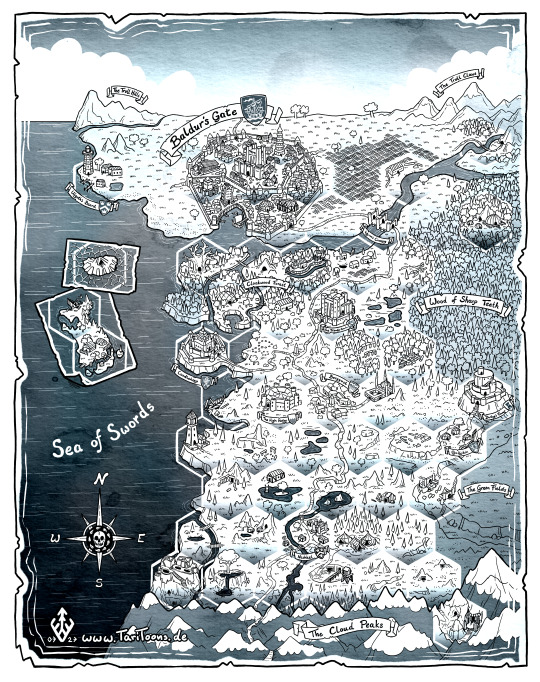
Full resolution hex crawl map of Baldur’s Gate and the sorrounding lands south of it, based on the in game map from Baldur’s Gate 1, including the areas from Tales of the Sword Coast and the Enhanced Edition. Took me about a week, easily the most detailed thing I’ve ever drawn. Full res version: [Click]
Inspired by JP Coovert on YouTube.
#baldur's gate#forgotten realms#Dungeons and Dragons#dnd#d&d#map#hexcrawl map#hex map#game map#sword coast#cartography#digital art#paint tool sai
79 notes
·
View notes
Text
So we've been playing with the idea of hex stickers.
Probably 2.5", just little art pieces for different locations or whatever.
Part of me wants to include lore
Part of me wants to make it a whole concept with monthly exclusives and whatnot
Part of me thinks it's just fun and neat
And yet NO part of me knows who would want these or find them useful in any way
So yeah, not sure WHAT to do with them

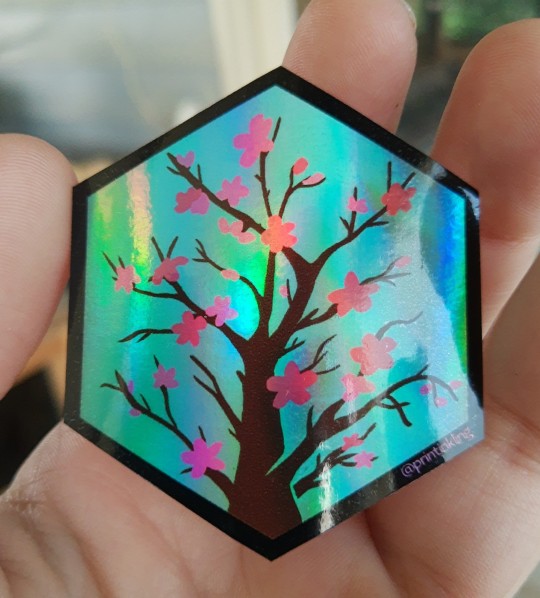
but thinking thinks and doing Things 🤪
#printinkling#artisan#stickers#hexcrawl#ttrpg maps#ttrpg family#ttrpg stuff#hex map#dnd#dnd art#ttrpg#dnd stuff#ttrpg community
11 notes
·
View notes
Text
Cereal Box Hexcrawl
I was at my day job grocery shopping about two months ago when, on the back of a store brand Cheerios box, there was a hexcrawl.

Okay, the box says it's a sudoku puzzle. I don't know shit about sudoku. It's a hexcrawl now.
The first thing I did was recreate the hexcrawl in Affinity Publisher. You could do this with any graphic editing software or even by hand on paper, I just used what I'm comfortable with. I counted how many of each number and wrote it on the side; I also created a blank template that you can use.

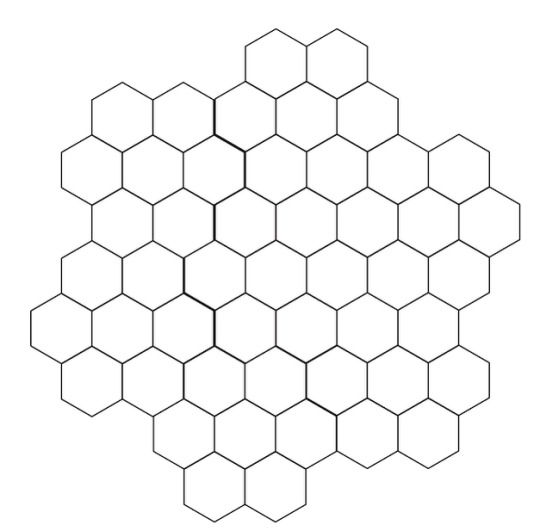
I left the "region borders" out of mine because I felt like they restricted the creativity too much, but you can add them back in.
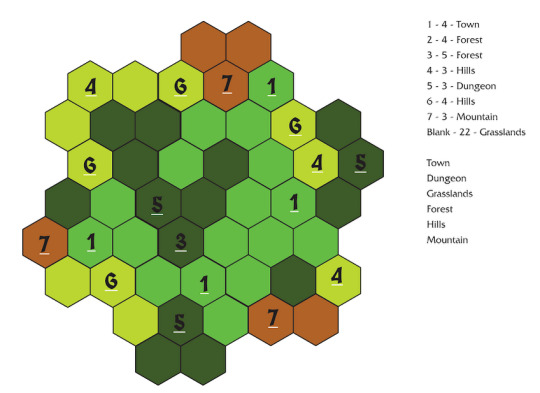
The next step is to colour the hexes. I assumed we would need towns, dungeons, forest, hills and mountains, so I grouped them together based on what felt right and how many I had of each. I then split up the blank tiles based on mostly grasslands but went with what was around.
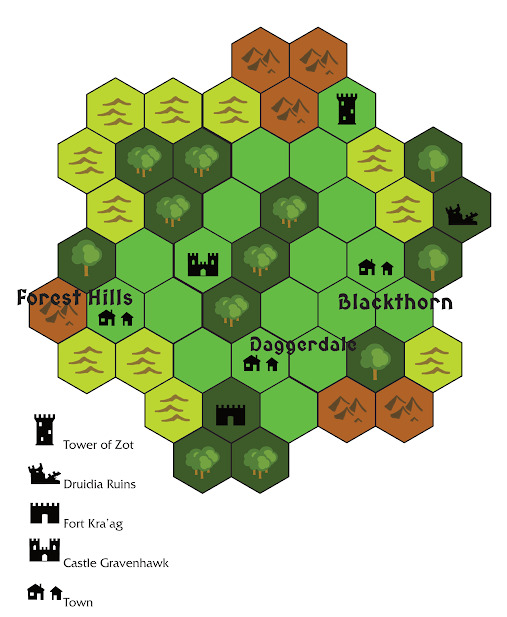
Lastly, I added icons from Hexographer. I named some evocative dungeon locations, some crap 5 minute town names, and boom--we have an adventuring location ready for play. This took about an hour and most of that was graphic design!
The icon packs I used are here:
https://welshpiper.com/packages/classic-hexographer-icons/?sfw=pass1685689538
https://www.hexographer.com/extra-icon-sets/multicolored-classic/
So, fine, I made a local area. But, my wife is also running a Spelljammer campaign, and needed her own local area. To the rescue: The Cereal Hexcrawl.
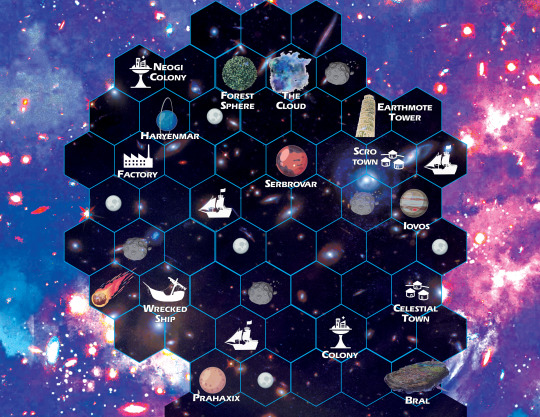
We named a few areas and generated some interesting locations using the tables found in Stars Over Stormwreck by Mike Shea of Sly Flourish. I can't believe this kind of stuff wasn't in any of the books for Spelljammer!
After we had our locations, we just spread them out based on the numbers we had on our hex map. We might have moved a couple around. Then, I opened my hexcrawl up in Affinity Publisher and did the work doing graphic design (including the space background). I've got a print copy of the map on 11x17 paper coming from Printkeg right now!
Protip: If you are doing a space hexcrawl or other kind of space map, for personal use, Googling "planet clip art" or other things like that is a GREAT resource. High resolution transparent background graphic representations of planets? Gimme that shit!
So you can see how easy this is to pull off. I made my original hexcrawl in about an hour over my lunch break, and that includes finding all the icons and stuff. It's so easy to come up with a local area from this and the iterations and changes you could make are seemingly infinite.
Get out there and make your hexcrawl!
3 notes
·
View notes
Text
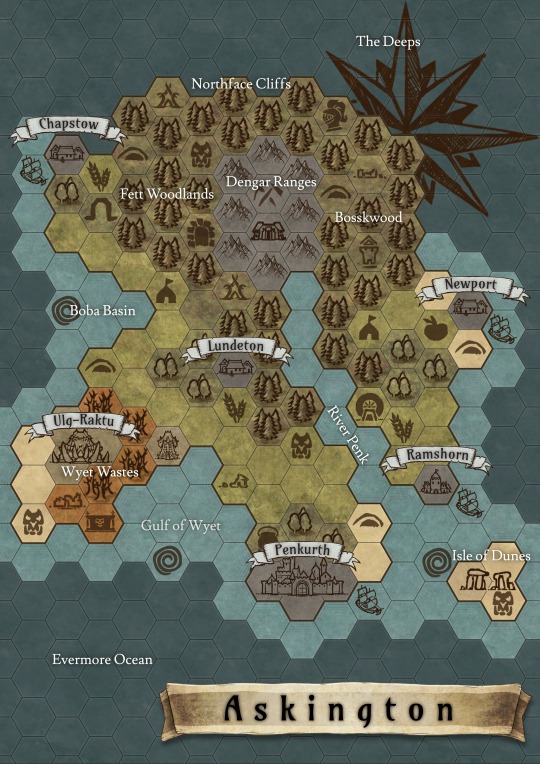
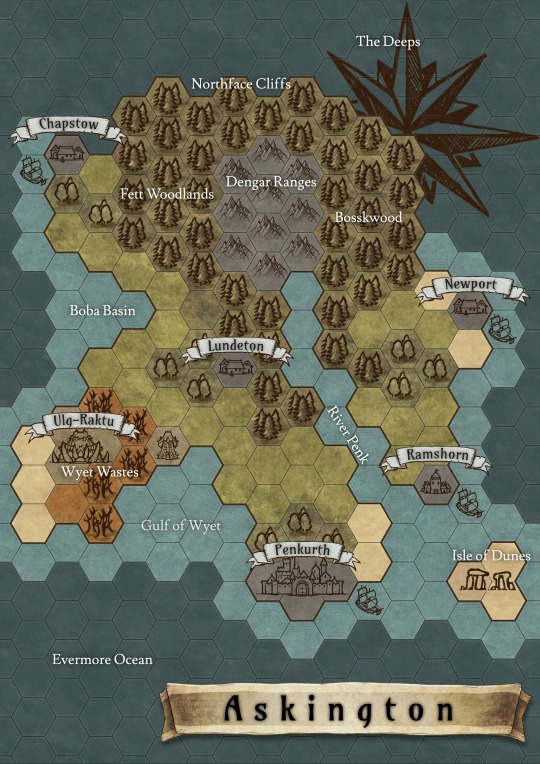
Hexcrawl maps for hexcrawlin'.
Made with Inkarnate.
Made for a school holidays program.
10 notes
·
View notes
Text
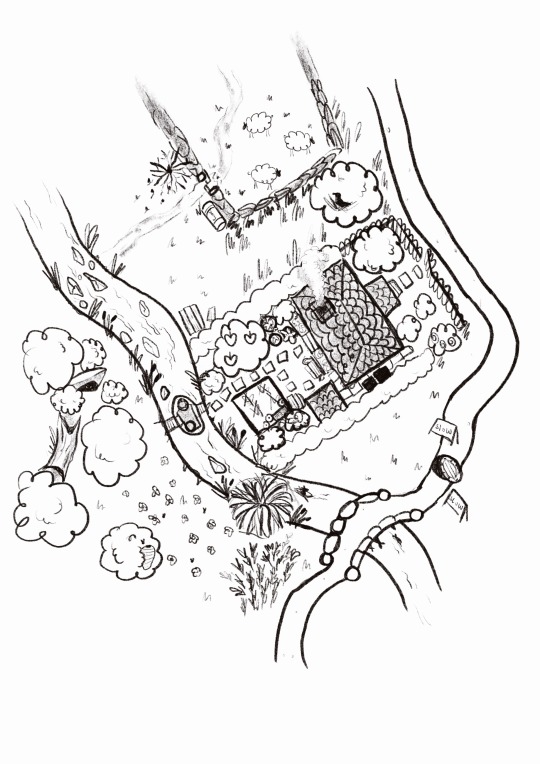
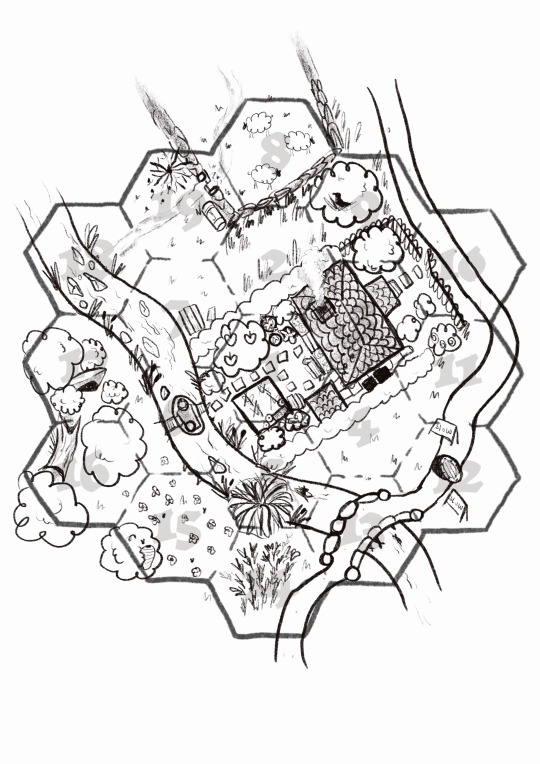
I didn't think I enjoyed Hexmaps and Hexcrawls, and then I made one for my Mausritter game. Turns out I just needed the right setting and then I was all in!
#mausritter#hexcrawl#pointcrawl#nsr#map#hex map#ttrpg#tabletop roleplaying#ttrpg design#mice in the herb garden#girls run these worlds
3 notes
·
View notes
Text
roughing out ideas for this Minauros hexcrawl like:
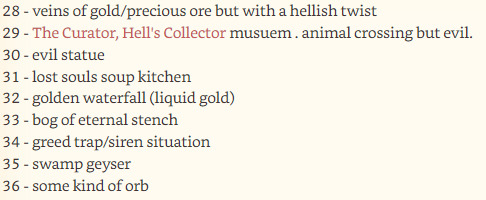
#ive never built a hexcrawl from scratch before i am DOING my BEST#i need to make the map as well#that'll be fun#my main goal is keep my players lost for as long as possible so my bad guys can advance their timeline#eventually they'll realise i'm stalling them but by then it will be TOO LATE
1 note
·
View note
Text
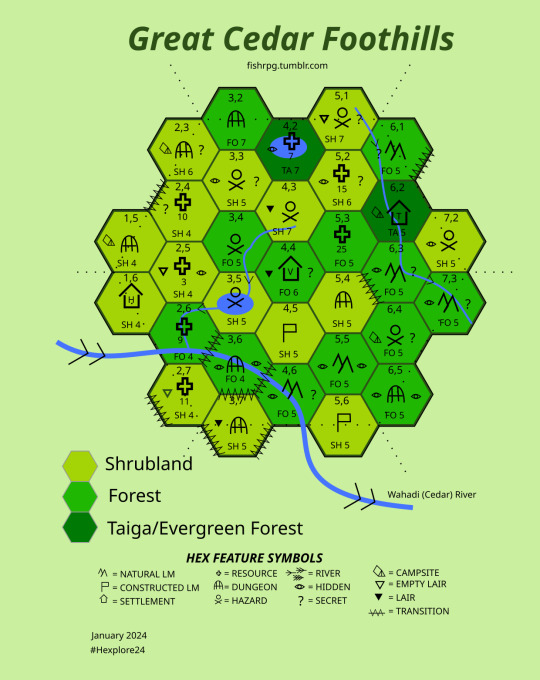
January 2024: The Complete Great Cedar Foothills
As a little bonus, here's the cool map for the finished January portion!
Here's the a listing of the hexes in a more usable order instead of the listing I encountered the hexes. Some of the links might be broken/missing because this is tedious and my brain shut off and/or forgot to update a day, so if you see anything weird, please let me know!
1,5 (2024-01-20)
1,6 (2024-01-19)
2,3 (2024-01-31)
2,4 (2024-01-30)
2,5 (2024-01-21)
2,6 (2024-01-18)
2,7 (2024-01-14)
3,2 (2024-01-28)
3,3 (2024-01-29)
3,4 (2024-01-22)
3,5 (2024-01-17)
3,6 (2024-01-15)
3,7 (2024-01-13)
4,2 (2024-01-27)
4,3 (2024-01-23)
4,4 (2024-01-01)
4,5 (2024-01-16)
4,6 (2024-01-12)
5,1 (2024-01-26)
5,2 (2024-01-24)
5,3 (2024-01-02)
5,4 (2024-01-03)
5,5 (2024-01-11)
5,6 (2024-01-10)
6,1 (2024-01-25)
6,2 (2024-01-04)
6,3 (2024-01-07)
6,4 (2024-01-08)
6,5 (2024-01-09)
7,2 (2024-01-05)
7,3 (2024-01-06)
Edit: forgot that I had this in the queue instead of in draft, so apologies if you ended up seeing the version that only had half the links!
0 notes
Text
A post of mine from several months ago about the Perlesvaus self-rearranging forest just wandered across my dash again and made me think about it some more, so I wanted to talk about it a bit.
Perlesvaus, for those who don’t know, is a 13th-century French Arthurian romance. It’s intended to be a continuation of Chretien de Troyes’s Perceval, but it’s mostly known for being completely batshit when it’s known at all. (There’s an old book on Arthurian texts that dedicates a chapter to Perlesvaus and repeatedly speculates that the anonymous author had Something Wrong With Him. This is the longest scholarly treatment of Perlesvaus I’ve been able to find & read.)
Anyway, there’s an odd worldbuilding detail in the text. See, it’s a Thing in chivalric romances that the questing knights happen upon castles & lords & damsels & such that are unfamiliar to them and have to be explained. You know, “this is the Castle of Such-and-Such, where the local custom is as follows. It’s ruled by Lady So-and-So, whose character I shall now describe to you.”
This is a genre convention that largely goes unquestioned, but it’s a bit odd if you think about it. All these knights are at least minor nobility. They don’t know the other nobles in their region? They don’t know what castles are where? Don’t they have, like, diplomatic relations with these people or at least attend the same tournaments? Even if they’re all fully committed to the knight-errant lifestyle and don’t really engage in courtly diplomacy, you’d think they would share information with each other and get the lay of the land. But instead, to use TTRPG terminology, it’s like they’re all on a hexcrawl that was randomly generated just for them to have these adventures.
The author of Perlesvaus decides to address this. In what’s kind of a throwaway paragraph late in the text, he explains that God moves things around so knights always have new quests to do (and, presumably, is also making sure they always arrive at the right narratively-significant moment). So the reason they’re always encountering people & places they have no knowledge of is because those people & places really weren’t there yesterday. They didn’t know about the Castle of Such-and-Such because it’s normally a thousand miles away and the forest path they followed to get there used to lead somewhere else.
And I think that would be a really interesting thing to stick into a novel or a TTRPG or something. When a knight rides into the forest with the intent of Going On A Quest, at some point they go around a bend in the path, cross an invisible barrier, and wind up in the Forest of Narrative. This is a vast forest with no set geography, filled with winding paths and populated almost entirely with questing knights, damsels in search of questing knights, friendly hermits, strange creatures, and allegorical set-pieces. Then, at the narratively-appropriate time, they cross back over the invisible barrier back into the regular world, and find themselves wherever the Narrative has decided they need to be. This could be a different country, a different continent, or a different world entirely.
Whether anyone involved is actually aware that this is how it works is… optional, really. Though if it’s not a Known Phenomenon, the people whose jobs it is to handle trade & diplomacy & god forbid, maps, are going to end up tearing their hair out in frustration.
2K notes
·
View notes
Text
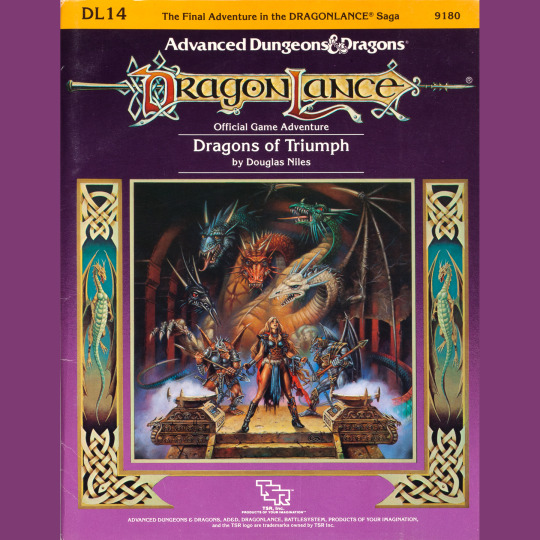
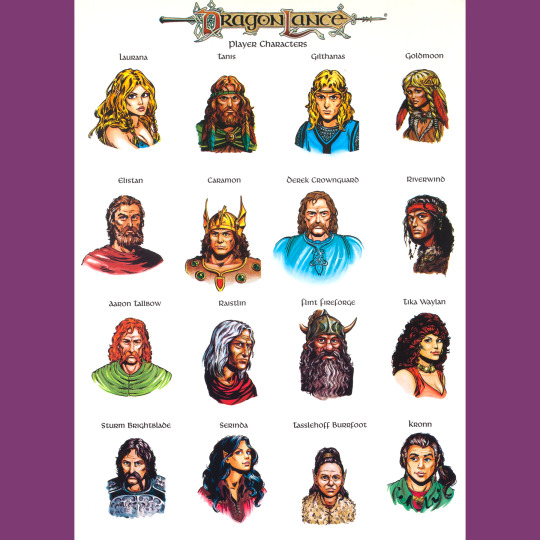

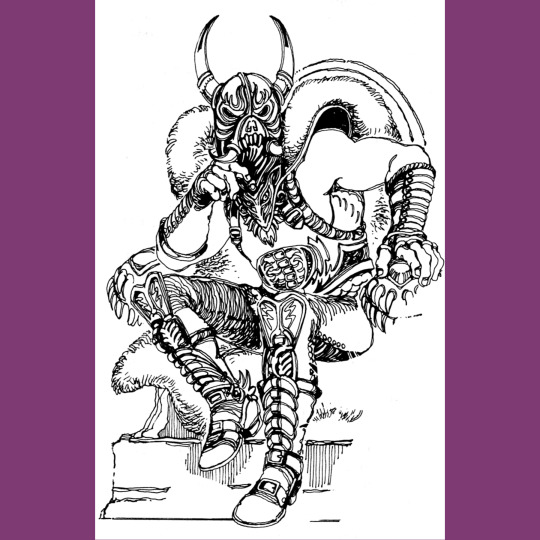




DL14: Dragons of Triumph (1986) marks the end of the the Dragonlance saga and the War of the Lance. It’s full to brimming — three booklets and a map. Some aspects seem rushed. Diana Magnuson’s art in general seems very sketchy here and the recycling of some illustrations from the 1983 Basic Set seems…odd for what should be a big budget, marquee release, the capstone on three years of campaign releases!
It’s interesting too that for all the series’ experiments in narrative and unconventional modes of play, the climax of the story proceeds along pretty typical D&D lines: a big ol’ hexcrawl, some city exploration followed by the final set piece in Takhisis’ temple, a mid-sized dungeon, where players enact the solution they uncovered in D13. There’s plenty of events, too, but the finish is refreshingly uncomplicated, I think? Also, I get WHY the adventures diverge from the novels, but I still miss the big character notes for Sturm, Flint and Raistlin. I don’t know how you keep those in without making a big mess, but I do wish it was a riddle that these folks figured out.
There’s a pile of extra stuff in the form of a sourcebook, a sort of sequel to DL5, which details the world of Krynn in a way that almost but not quite supports further play. That’d have to wait a few more years. There’s also a collection of all the monsters, which, they all appeared elsewhere, but I like it when monsters hang out together.
Also, old saw, but as much as I like this Caldwell cover, I also think it sucks in the way it diminishes the strength of Laurana’s character. Compare to Elmore’s depiction on Winter Night or Parkinson’s fantastic portrait of her standing over Sturm’s corpse. It bums me out on a certain level that she’s chained and pantsless in typical Caldwell fashion on the cover of the finale. Takhisis looks great tho.
#roleplaying game#tabletop rpg#dungeons & dragons#rpg#d&d#ttrpg#Dragonlance#Dragons Of Triumph#DL14#noimport
111 notes
·
View notes
Note
Hey, I've been thinking of maybe getting into TTRPGs, but I don't really have any friends in person that are into that sort of stuff (I do have online friends who are into it, though). Do you have any recommendations for a/some good "solo" ttrpg for beginners.

THEME: Free Solo Games for First-Timers.
Hello friend! I managed to find a whole cluster of free roleplaying games, so I hope you find something here that tickles your fancy! There’s some story games, some survival games, and some that are in between.

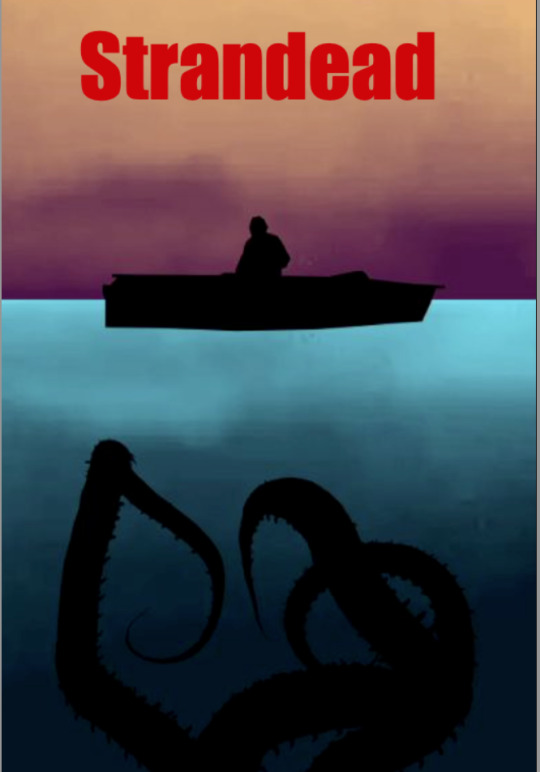



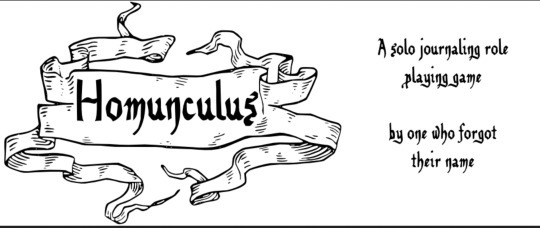
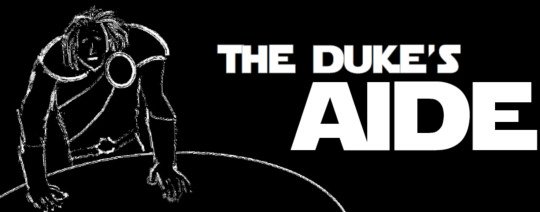
Lycans & Lawyers, by GorgonHead.
You are one of Capitol's top lawyers. You also turn into a werewolf at night.
Welcome to Moondale, one of Capitol's nicer districts! Your law firm is based here, and most of your clients come from here. It is you job to keep them from getting convicted, even if they are guilty.
And they are. You must employ your best skills, both as a lawyer and as a lycan, to keep them safe from the Union's law long hands. To manage this, you'll have to do some shady things. But it's all for the good of the client!
This is a simple, one page game with a lot to play with. It has a few paragraphs of lore, a map to help you visualize your neighbourhood, and two moon tracks to follow. You’ll have two different sets of stats depending on whether you are in your werewolf mode or your lawyer mode, as well as a series of roll tables to set the scene. If you like a concrete goal but also some flexibility in the details that you get to contribute to the story, you might like this game.
Strandead, by chuymarin.
Awakening amidst the boundless stretch of the open ocean, the unsettling sensation of isolation grips your soul. What lies ahead in this abyss, lurking within the depths of the ominous waters? The weight of impending threats gnaws at your very core.
A solo hexcrawl for the survivalist at heart. Travel across an ocean and roll for encounters, fish, and random items as you try to survive for X number of days out on the open seas. With two difficulty modes and an optional QR-linked random generator of rumours, you’ll have an excellent combination of randomness and strategy to keep you invested. Perfect for folks who prefer balancing numbers and don’t want to fill in a narrative from prompts.
Fortress in the Frozen Wastes, by August Wigg.
Set in the post-apocalyptical land of the Frozen Wastes, a young Ranger must journey to an outlaw fortress to rescue their captured mentor and a group of settlers. Customize your Ranger to be proficient in different skills and choose different paths as you attempt to save the prisoners of the Fortress in the Frozen Wastes.
This is a combination of a traditional roleplaying adventure and a choose-your own adventure story. You’ll create a character sheet with stats, character abilities and inventory slots, and success and failure depend on a d10 roll. Your character dies if their endurance ever gets to 0, so you’ll do your best to navigate each new situation you encounter and make choices that keep your ranger alive long enough to fulfill their quest.
5 Min Knight, by enui.
5-Min-Knight is small one-player RPG about being a Knight of the round table. It takes 5 minutes to play.
This is basically a writing challenge, with a number of d6 tables that you’ll use for writing prompts. You are meant to roll and write as much as you can in 5 minutes - when the timer is up, you roll again to see what called you away. This is a great exercise if you’re looking for a way to practise your creativity, or if you don’t have that much time in a day to play.
If you’re more interested in solving mysteries, you can also try 5 Min Maven, by the same creator, inspired by Brindlewood Bay!
Curiosity Killed?, by Zole Tsoi.
Playing as a cat wandering the streets of a futuristic city, you are tasked with helping ghosts of the underworld who have unfinished business.
This is a one page game that uses a d4 for pretty much everything. You’ll want to keep an eye on your three stats, because if they get too high or too low, your cat is forced to end their mission early or gets stuck. Get your Stress down to 1 or your Morality up to 5 to win the game!
Homunculus, by DOMINO CLUB
Alchemy is a dirty, tiring, thankless job. I’ve let this absorb my whole life, and I’ve now gotten to the point where I’m ready to move on.
In this game, you play as an homunculus, newly created by an alchemist to explore the world .
Homunculus is a game that starts you off with quite a bit of guidance, easing you into play by setting you up with prompts connected to cards you draw from the deck. Card suits are connected to four stats in this game, which you will attempt to increase equally in order to gain the best possible ending. This game allows for a few replays if you are interested in getting different endings, but it also relies on interpreting prompts as drawn by the cards. If you like a game where you’re reaching a specific target, you might like Homunculus.
The Dukes Aid, by g0ri.
On the frontiers of space, an interstellar empire exists in a perilous balance. As a close aide of a Duke and his house, your job is to navigate safely through the coming intrigues.
Observe the plans within plans within plans as your House takes over the production of the Empire’s most important resource.….
The Duke's Aide is a solo roleplaying game requiring at least half an hour, a set of roleplaying dice, a deck of cards and something to write with and on. This is a proper journaling game, using a deck of cards to supply prompts, jokers included to help pace the game out for you. You’ll choose a character class, which also determines the dice you roll, which you’ll need every time your character tries something risky. This is a great introduction to a journaling game that still gives you a lot to work with if you don’t feel super comfortable extrapolating from prompts.
Games I've Recommended in the Past
The Wandering Library, by AP.
83 notes
·
View notes
Photo

Drafting the Adventure: Wilderness and Exploration
For a game with exploration as one of it’s “core pillars”, d&d is kinda shit at producing gameplay conducive to actually making players feel like they’re exploring.If you play it by the book travelling from point A to B often feels like a slog, and a good number of groups are completely justified in skipping it entirely and just getting to the good bits. I think the problem largely stems from trying to cram the hexcrawl/westmarches style of gameplay from d&d’s heyday into the central gameplay loop when really it should be the focus of very particular kinds of adventure. Think of a big exploration adventure the same way you’d run a heist or murder mystery, usually a one off unless you’re running a specialized campaign.
With that said, the base rules for hanging out in the wilderness are IMO in massive need of an overhaul, so we might as well overhaul those along with setting up a good guidelines for running an exploration based adventure. Before we dive under the hood and get into all those storybuilding steps and mechanics, lets look at how my system works from the players’ perspective:
In lieu of any urgent quests or fantastic job offers, a group of adventurers decide they’re going to explore the wilderness outside their settlement and look for some opportunities.
One character chats up the locals, hearing rumours of what might be going on outside the walls. The second does some research on the area and finds a few trustworthy maps to copy. Another checks the local bountyboard for outlaws and monsters it might pay to hunt down.
The party sets out, and the DM asks the party which player wants to be the group’s surveyor: keeping a list of what places the party has visited, what options are available to them, and what might need a bit more exploration.
The DM has divided the area they’re exploring into zones with names like “The forbidden peaks” or “ The merry meadows” which gives each area a strong geographic identity and makes it easy for the party to remember and gives them an idea of what to expect.
Every time the party walks into a new zone, they learn the area’s name, and how many “points of interest” are in that region. A point of interest could be anything from a unique environmental detail to the lead in to an encounter to a monster lair to the entrance to a whole dungeon. The surveyor keeps track of these points of interest, making space to write in whatever details they think are relevant.
Likewise upon entering into a new zone, the party are made aware of “landmarks” striking points of interest that are obvious to the naked eye and don’t need to be searched for. Because this group prepared before they left, they’ll likely have learned of a few more points of interest in the region based off the information they gathered.
When the party have fully explored a point of interest, the DM tells the surveyor to check off the name of that location, indicating that it’s safe and that the party can turn their attention elsewhere
When deciding where to go next, the party has two options: Set out for a specific area (one they know about or have visited before) or to Wander, poking around till they find a location they didn’t know about previously. The DM may ask for checks while the party is traveling based on the difficulty of reaching the point of interest or the particulars of the zone they’re travelling through.
Because the DM has been upfront with how many points of interest are in the zone, the party have an understandable goal of filling in a list and checking off each location. This feels like actual exploration because the party is actually making the decision of where to go and how deep to search, combining those key elements of choice and discovery that make setting out into the unknown so rewarding.
Below the cut I’m going to go into detail about how to BUILD an exploration adventure, everything from designing goals to fit your narrative needs to choosing what kind of points of interest to seed into the world .
First step: Setting Bounderies
When preparing a wilderness adventure, you’re going to settle on an area that the party is exploring and why: are they low level nobodies knocking about the countryside surrounding the starting village till the call to adventure finds them? Are they high level heroes looking to comb a vast wasteland for the location of a forgotten temple? Are they desperate survivors battling the elements as they attempt to find a pass through the deep wilderness? Obviously these will set the scale and tone of your adventure, but they’ll also help you define your boundaries: are your party moving towards a specific goal, or are they fucking around? Are they able to return to the comforts of civilization on the regular, or are they on their own? Is their exploration more of a self driven sandbox, or are they trying to find a route to a particular destination fellowship style.
Perhaps most importantly you need to ask: SHOULD this adventure be exploration focused? These sorts of adventures are a lot of work and if the party is only going to go through this region once you might be better served by just planning some encounters and pantomiming the idea of exploration in your narration.
Second step: Zoning it out
Now that you’ve settled on your region, you’re going to start cutting it up into Zones, large areas with a distinct geographic identity that will stick in your party’s mind: the area around a village might be divided by its cardinal points into fields, swamp, forest, and hills, able to be explored in any order, where as an attempt to cross the mountains might be separated into a sequence of 1) foothills 2) a choice between peaks OR caverns 3) river 4) lake. Obviously you’ll give each zone a striking name as you develop its theme that will help reinforce its identity by the time you present this to the party. I’d recommend three to six zones, as any more than that it gets hard to differentiate them from eachother.
Third step: Making lists
Now comes the fun part in designing your points of interest. I’ve found this is a two part process of brainstorming physical locations within each zone and determining what sort of encounters might happen there, though often times the latter comes before the former. It’s important to remember that an encounter is more than a fight, and fights are more than just face to face combat. Here’s some ideas to get your brainstorming started:
Generally you’ll want atleast four and a maximum of twelve points of interest per zone ( though I tend to default to six) this is not only to prevent you from having to make too much content, but also to be able to use a die to determine what random point of interest the party finds when wandering. Every 2 locations they check off your list, decrease the die size.
Between landmarks and information that a party can gather through rumour/studying maps, I’d advise having no more than half your Zone’s content discoverable before the party actually starts wandering. This is to preserve the sense of the unknown which is vital to feeling like exploration means something.
Landmarks are like billboards drawing your party to particular content, ranging from natural features like hills or rivers to ruins or statues. Use them to deliver details the party should know about the zone early.
Trails or other signs of habitation are your friend, as they allow you to tease what an encounter MIGHT be without giving things away immediately; bandit ambushes, lost travellers, local wildlife, all of these could be at the end of a trail, but it’s far easier for you to bait the party with their own curiosity than come with an obvious “this place looks like a trap, do you want to step in it?”
When it actually comes to combat encounters, I’d advise balancing how challenging the encounter is with how much forewarning the party has. Ambushes they walk right into should be easy or very easy, while medium and hard encounters should either be opt in ( seeking out a beast in its lair) or avoidable ( hiding while the chimera circles overhead)
Points of interest can have many things to discover within them, such as frontier settlements, or Structures and Caverns which can be run as small dungeons.
Some locations may act as gateways into different zones. This is particularly useful for overland travel adventures where the party has to find the right point of interest to lead them on to the next phase of their journey.
For longer explorations it’s a good idea to include “safeholds”, places the party can use as a campsite rather than roughing it in the wilderness an being exposed to the elements or the threat of random encounters.
Puzzles and scavenger hunts are amazing activities at points of interest, especially if the party needs to go somewhere else in the zone/area to solve them.
Need to express that one particular point of interest ( or perhaps a whole zone) is difficult to traverse? Have the party roll con saves to avoid exhaustion/survival checks to find a better route. You can likewise do this with stealth checks to avoid the patrol routes of enemies or the hunting grounds of vicious predators.
#dnd#dungeons and dragons#d&d#5e#pathfinder#ttrpg#dm advice#dm tip#dm tips#dm tools#writing advice#homebrew#DnD Mechanics#d&d mechanics#homebrew mechanic#Wilderness#exploration#random encounters
314 notes
·
View notes
Text
Play Report: Tacticians of Ahm #2

Tonight, I ran the second session of an ongoing playtest of an upcoming starter Tacticians of Ahm adventure I'm hoping to get out in the February update (the game is itchfunding now). So, here's a play report (and here's a link to the first play report)!
After the chaos of the griffin attack on the Academy's field day, everyone went back inside the Academy walls for safety. Both griffins, including the one carrying Von Lopesbane, flew off to the northeast, after getting hit by enough attacks from the professors and student tacticians below to be thoroughly annoyed.
Inside the walls, the party saw a number of scouts coming in from the north, west, and eastern roads, all with the same news: sightings and reports of imperial soldiers (even several skyriders - the empress's griffin rider legion) attacking Ahmian citizens - all while proclaiming to be fighting back against the corrupt1on!
Groups of Tacticians and their advisors began to form parties to go out and address these various reports - after all what's a better final exam than the real thing? Professor Dana Turr, an elderly naga woman and the Senior Term headmaster, gave the group an option (since their advisor, Von Lopesbane, was missing): Find Von Lopesbane on their own and it will earn them a guaranteed early graduation and exemption from the remaining weeks of exercises. The other Tacticians on site at the Academy are spread too thin with more violent reports nearby, but she can't abandon Von Lopesbane and if the imperial army is involved, this could be serious enough to actually mean he's in serious risk.
The group agreed and were sent off to Quartermaster Bormos to get field equipment before heading out: 5 rations, a healing potion, and a piece of equipment (under 25g) of their choice. Both Tacticians took Leather Armor. Quablin bought both of them backpacks for the road.
The group headed out, into the region northeast of the academy in search of Von Lopesbane.

The party was somewhat familiar with this region from their time at the Academy. To the north was Four Families, a collection of four family farms all housed very close to one another - the road eerily quiet. To the east, the village of Dodona - smoke rising up from that direction in the distance. To the far north, ruins of an old war watchtower, formally abandoned for centuries.
Helios pushed for the group to head to Four Families and then east towards Dodona. The road was strangely quiet on the way (no random encounters were rolled).
They arrived at the farmhouses and found it, again, strangely quiet. They approached the nearest house and a halfling farmer whispered at them out of the shrubs - There are soldiers in the house! They attacked the other houses and his family only just made it out in time.
Helios approached the house and tried to convince the soldiers inside that she was a higher ranking officer, but the soldiers were assured in their mission, claiming Helios to likely be an agent of the corrupti0n. Frustrated, Helios kicked down the door and rushed in!
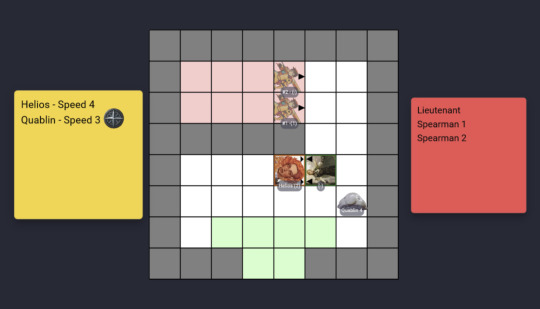
Over a 4 round fight, the Tacticians faced 1 Lietenant (EL2) and 2 Spearman (EL1). Through a clever use of Stupor to stun two of the enemies followed by a perfect backstab from Helios the group took the fight but both were just a strike away from falling. The gained 1 XP, 1 RP for their combo and leveled their Relationship to Level 1.
They questioned the defeated troops, you seemed out of sorts, babbling about corrupt1on, being far from home, and the vile nature of the White Walled City - almost as if the concepts of D4RKW3LL and Ahm were swapped in their mind.
Next time, the party travels onward!
[Design notes: We were testing some changes/expansions here to overland travel as it is currently written in the published rulebook. It's more of a node-based pointcrawl than a traditional hexcrawl (like the FF Tactics overworld map). The other thing I'm focusing on going forward in playtests in holding myself better to the digital nature of the world and highlighting those aspects (and providing guidance in the rulebook for GMs to know how to do the same).](edited)
Tacticians of Ahm is itchfunding now and it currently at it's lowest price (just $15 USD) with monthly updates coming from February to September of this year (and hopefully beyond)!
30 notes
·
View notes
Text
Role-and-Write games?

Every once in a while I browse through the many design contests on Board Game Geek website. I'm an enthusiast of print-and-play, solitaire wargames and portable stuff myself so it wasn't really a suprise when I ended at the 15th ROLL & WRITE GAME DESIGN CONTEST page today. For those asking themselves what is that,
"[Roll-and-Write Games] are (usually) small and portable games that involve players rolling dice and marking the results on sheets of paper or erasable boards. Another common factor is that marking choices made in previous plays limit a player's marking choices in future plays."¹
When I noticed two hours had already passed and I was looking at all the entries of the last years. I've had some good experiences playing this subgenre of boardgames in the past, but only now I'm asking myself the right question:


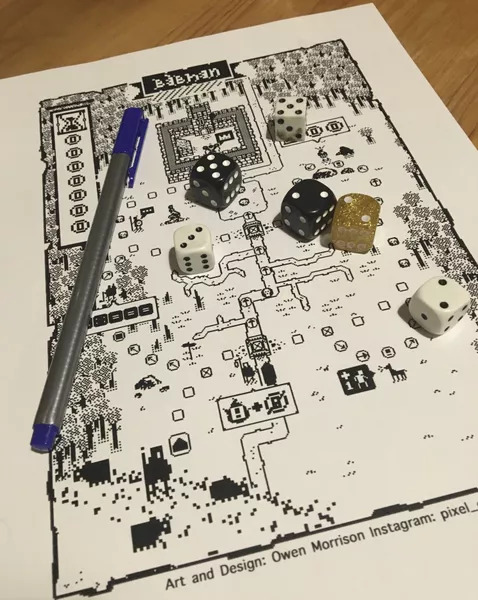
Why not add roll-and-write mechanics into Solo RPGs and Gamebooks?
Gamebooks, specifically, are a suitable medium to carry roll-and-write mechanics into their pages. I can't see why they still don't actually. Afterall, they already share a lot of the same traits of R&W
both portable;
both affordable;
both solitaire-first;
both low-cost in terms of production
I believe R&W mechanics could be integrated into gamebooks as subsystems or even just as minigames that would bring some breath into the usual roll-against-attribute loop. Not only that, but they actually allow the writers and the readers to deal with gaming experiences that are simply not possible trough conventional gamebook practices.
Just imagine if you need to ask the player to
map a region with random encounters;
hack into a computer by solving a sudoku-like puzzle;
fix a spaceship engine using creativity;
design and build a fort;
go through a tactical movement combat.
The intersection between gamebooks and boardgames are also not that new
I'm not inventing the wheel here. Barbarian Prince did that in 1981 and and the Middle-Earth Quest Gamebooks actually proposed a very sandboxy hexcrawl mechanic in 1985. Another obscure example is the Nintendo Gamebooks published between 1991 and 1992. Targeted at young children it's main mechanic was all about newspaper style pencil-puzzle challenges. 40 years ago these ideas were being published and I feel the entire Scene has been sleeping on them since then.
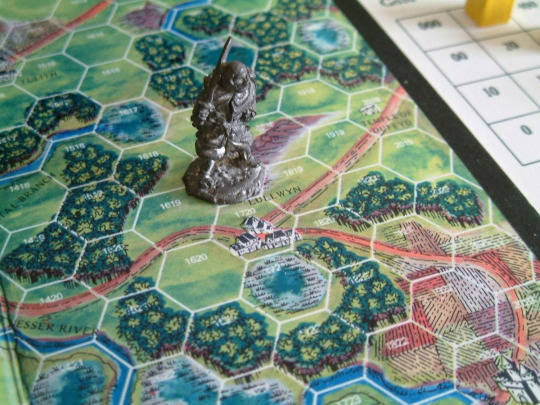


I don't have an answer on why that happened. My biased guess would be a purist prejudice against boardgames merging into roleplaying games, but I may be completely delusional of course. I hope so, really. All I know is that I'm already buying, downloading, playing and studying a lot of Roll-and-Write games and seeing the possibilities expanding in front of me.
14 notes
·
View notes
Text
I think part of the reason why the earliest Loremaster adventures (for Rolemaster) like The Iron Wind and The World of Vog Mur were like that (very atlas-like, very zoomed out descriptions of places and peoples, without any of the nicely gameable abstractions of D&D like dungeon maps to act as separate "adventure zones") has something to do with the idea that dungeon crawling was seen as the D&D activity. Rolemaster doesn't have rules for dungeon procedures in the same way that D&D does, and it is trying to be more of a fantasy world simulator system than a dungeon fantasy game.
I think the dungeons as a separate adventuring environment was sort of seen as a mark of D&D which was seen as more sophomoric than serious fantasy RPGs. I don't necessarily agree with that although I do think "dungeon crawls" as a genre of play easily demonstrate some of the worst parts of fantasy roleplaying as a genre if you're not careful, but as purely gameable challenge environments? They provide a nice bit of structure.
Anyway I've mused about this before, but the ideal to me would be something like The World of Vog Mur but presented with an eye towards making it easy to run like older dungeon adventures. The zoomed out nature of the early Loremaster adventures means that while there's a lot to play with there, there's very little actual guidance, meaning that it's putting a lot on the GM's plate. I think some modern hexcrawl and pointcrawl adventures get very close.
27 notes
·
View notes
Text
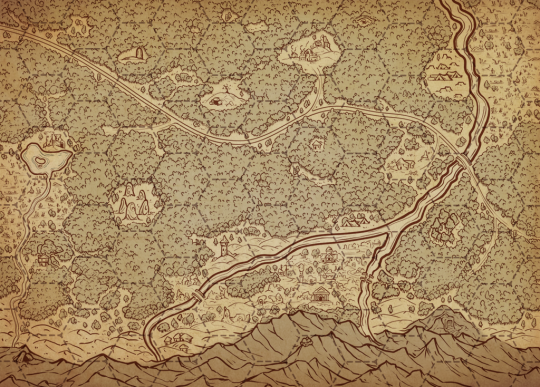
A hexcrawl map for my last campaign. We've just finished it and I'm already missing that adventure. Can't wait to start a new one :) Players were playing as a goblin tribe whose home village was destroyed by vile adventurers. So our little green heroes were trying to find a new home and survive in this cruel world.
#art#artists on tumblr#fantasy#illustration#dnd#dnd art#commisions open#fantasy art#my art#fantasy map#dnd maps#cartography
8 notes
·
View notes
Text
No. 4 - D1, Descent into the Depths of the Earth (August 1978)
Author(s): Gary Gygax
Artist(s): David C. Sutherland III (Cover), David A. Trampier
Level range: Average of 10, preferrably party size 7+ players
Theme: Underground exploration
Major re-releases: D1-2 Descent into the Depths of the Earth, GDQ1-7 Queen of the Spiders
Wait, really? This adventure has never gotten an official adaptation after 1e? That feels really weird. Granted Queen of Spiders in particular would absolutely work with 2e, but, wow. Is there a reason for that?
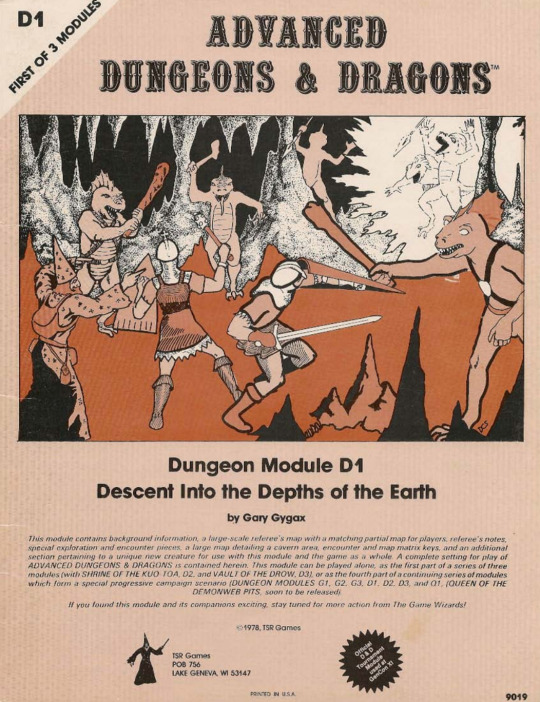
Ahh, 1e cover art. Looks like hot fucking garbage in the best way. Well, at least it's not a trace? You may be aware that early DND had a bit of an art theft problem (mostly stealing off of comic covers), but I don't actually have a list of all the known cases -- finding art credits at all is enough hassle as is without tracking down which paintings are also stolen. The usual suspect is "Greg Bell" and if you want to look this up the word you need to google is "Swipes", not traces. Just, be aware that's a thing going forward.
We start off on a weak footing: a light retcon. The ending of G3 didn't really imply that the drow had an escape route to the underdark in the Hall, at least not going off the map, but the text of D1 does. It didn't really even have a reason to pursue any drow into the, well it's not called the Underdark yet. In fact, it's going to be a hot minute til then, it'll receive that name in '86 from a not particularly liked supplement that got pumped out during the TSR Money Issues era. So for now, it's just The Depths.
G1-3 were highly enclosed dungeons, D1 is a wilderness hexcrawl situation. Which is kinda strange, since like the G series, the D series was a tournament module. The answer to this conundrum, is that it isn't a conundrum, because only D2-D3 were used at GenCon XI, as well as an alternate Q1 that never was. Shame! The Lolth egg raid sounds cool.

A big hexcrawl, in fact! It's almost weird to me that D1 is the middle of a sequence at such a high level, rather than the beginning of a sequence at a low level, simply because there's so much stuff? Hexcrawls aren't my jam (admittedly I've only played in one ever, but I have Forever GM syndrome very hard so maybe one day that'll be fixed…) so it's hard to not see something this huge and go "wow this must be totally overwhelming to run". But we will press on dauntlessly!
We get some guidance on how to run this, including to really sell the "spooky cave" vibes. Gary is one again strangely invested in the importance of caving itself, but here it feels a bit more appropriate than it did in G2. Happily, shockingly, excellently: there IS a way to secure the Drow's favor from the word jump! Wiping out the Mind Flayer camp will have a, not 100% but extremely high chance of the drow FINALLY leaving you alone. Yay! And included in the module are some bonus cave battlemaps in case you need to random encounter in a cave. Also yay! Actually, in general in this introductory section Gary is generally sending out good game design vibes, going to great trouble to mention "if they're being careful, don't fuck them over" and "just straight up tell them you can't teleport very far down here" and "make sure you tidy up this framework into a real adventure". All very good signs!



The artwork is, broadly, much cooler than it has been up to this point. Which is good, because we're getting a whole lot of random tables here. They do a nice thing in this section, where they give 'purposes' to a lot of the random encounters, not full-on spark tables but at least knowing that the ghouls serve the drow is a very handy "why are they here?" to know.
The adventure lightly, reasonably, railroads you into your first encounter -- a checkpoint. It's a pretty rote fight, there are two factions but they can't really be posed against one another in any obvious way. The sub boss has a faerie fire grenade, and the big boss has a cloak that lets you turn into a lurker to fly away in a pinch. It's lightly teased that they worship Lolth here. But otherwise it's mostly just "welcome to the underdark motherfucker!"
There's a brief illithid encounter, which is likewise rote. Chop em' up and move on.
Finally, you have your dungeon-dungeon, which is a trog warren. It's mostly just Some Drow and Some Trogs, and it almost feels obligatory? It's got that "bunch of random caves" vibe that I do not like in dungeons. B1 and 2 will both end up doing this. But among the funny things is:
The first appearance of a death lance (drains d4 levels) on some bad motherufcker drow fighter lady
The medal you can negotiate from the drow can also just be looted
A lich is just, kind of taking a nap. the cheeky little fucker has put a magic mouth on basically everything everywhere, so you're flooded with magic aura if you think you're going to see shit coming. He's got some really neat shit, like a portable hole, but unfortunately his non-magic valuables are extremely cursed. Figures.
Sometimes I forget that ghouls and ghasts are sentient and intelligent, since I have had it so trained in my mind that ghouls are essentially smart zombies rather than people in any meaningful sense, but not so in ADND land! These ghouls are trying to ditch the drow they serve, which, understandable.
Thing I only learned now: ADND had many, many sphinxes. Andro (big tough and good), crio (smaller, dumber), gyno (smaller, a little meaner, classical sphinx behaviors including riddles), and hieraco (evil, vicious, and animalbrained). Ours here is the hieracosphinx, which is a pet of some drow lady.

Hopefully we can agree that old timey bugbears were silly little guys. I don't buy that they're evil, they're too silly! And yawn the usual lady monster / child monster dilemma is here, how droll. Your party picked a side 30 sessions ago and now it's just procedural.
Apparently the dark elves and trogdolytes practice mutual aid with one another, though Gary specifies it's coercive so not like that put your flag down. I do think it'd be pretty funny to reveal that the trogs are Actually Really Good and have a lot to teach others about societal organization. There's not really much to say about it as-written, it's just more of that mothers/child dilemma tripe.
At the end, an actually cute little trick that I cannot fathom the party ever working out without the Drow Merchant just straight telling them: There is a room with a magical pool in it. The pool is surrounded by a ton of small gem, which if removed, magically reduce any nearby gems in size and value. But, if you toss gems into the pool, they increase in size and value. Neat! Infinite money machine!
The adventure ends with the unveiling of a new monster-people: the Jermlaine, which are basically just mean little guys who sneak around and cause trouble. Not really a threat, just extremely annoying. Your guys will wanna chop them up for being assholes, but really they're just like the most petty guy at your job. It's a weird addition, but not unwelcome. On the whole, D1 is some lovely and mildly ambitious connective tissue bridging the D series together, and I'm actually kind of fond of it now. Maybe my players will visit The Depths soon…
The adventure ends on an illustration of ya bois taking care of some trolls and shit. Thanks Dave!

6 notes
·
View notes